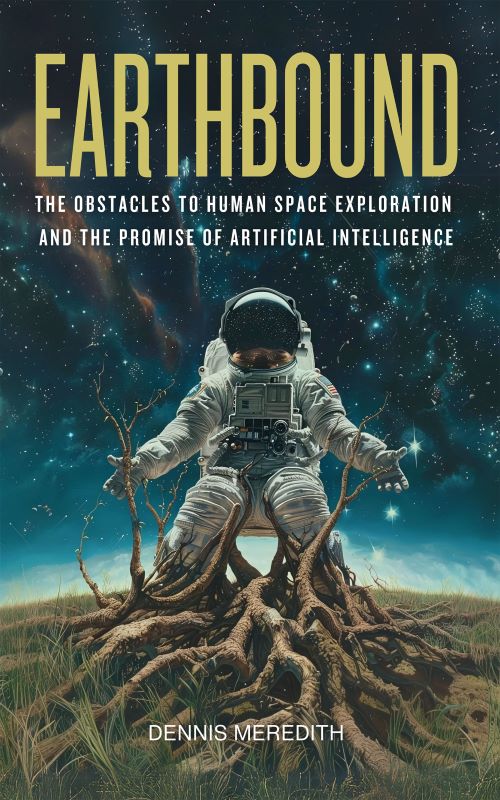AI robots, not humans, are the future of space exploration, says new book
The overwhelming hazards of radiation, weightlessness, disease, toxic chemicals, and psychological trauma mean that humans cannot survive in deep space, according to the new book, Earthbound: The Obstacles to Human Space Exploration and the Promise of Artificial Intelligence.

The book cites a multitude of scientific studies on organisms from cells to humans revealing the profound biological, medical, and psychological impacts of the deep-space environment. NASA itself has recognized the severe, unsolved “Red Risks” of space travel, including radiation health impacts, vision problems, cognitive decline, and inadequate food and nutrition. And, researchers have conceded that they cannot reliably estimate the medical risk of deep-space exploration missions.
Instead of a human space program, Earthbound advocates that deep-space exploration be mounted by neuronauts—artificially intelligent space probes collaborating with scientists. They could explore exotic realms from Martian caves, to Europa’s oceans, to Venus’s murky, superhot atmosphere. The data they gather could be used to create a Virtual Cosmos that all of humanity could explore, experiencing the wonders of the solar system.
“The book aims to persuade decision-makers to avoid a massively expensive—and in the end inevitably tragic—human deep-space program,” wrote author Dennis Meredith. “In its place I advocate a sensible space program based on the more realistic, productive, and cost-effective use of sophisticated, artificially intelligent robotic space probes as the technological and sensory extensions of humans.”
The book reveals that the inspirational, economic, and other rationalizations for human deep-space exploration are deeply flawed. “They are generally vague, hand-waving arguments; and when their merits are closely examined, they lack substance,” wrote Meredith. “One might compare them to hollow chocolate Easter Bunnies—appetizing on the outside, but with nothing on the inside.”
“Abandoning the unrealistic plans for human deep-space travel would enable us to chart a path to space that will be infinitely more likely to be successful,” wrote Meredith. “Imagine the prodigious exploration possible if the immense cost of the human space program were applied to robotic explorations. And imagine how inspiring and educational those explorations would be if the world’s peoples could join the experience through virtual reality and telepresence technologies.” Meredith noted that NASA expends almost half of its budget on the human space program.
The research detailed in Earthbound reveals that deep-space travel is a “serial killer,” as are lunar and Mars missions. That is, they are like the serial circuits of old-time Christmas tree lights, in which the loss of one defective bulb extinguished the entire string of lights. Similarly, in deep space a single medical catastrophe amid untold possibilities could end in astronauts’ death or disability. Any organ—heart, lungs, immune system, brain, or eyes—could fail. And the severe limits on medical capabilities in deep space would prevent treatment.
By contrast, wrote Meredith, robots do not have “lungs that could be clogged by swirling dust; other organs that could be damaged by radiation; or muscles or bones that could be weakened by years of weightlessness. None requires a narrow range of temperature or a constant supply of air, food, and water. And, thus, none require the gargantuan amounts of money, fuel, and supplies necessary for human missions.”
“NASA and private companies are already developing and using AI extensively for space exploration. They are using AI to land rockets, dock spacecraft, assist astronauts, manage maintenance, design spacecraft and missions, navigate satellites, analyze data, track space debris, monitor astronaut health, detect planetary geological features, and recognize patterns in astronomical images.”
Earthbound explores the political pressures driving the human deep-space program, particularly advocacy by cosmic cheerleaders—including self-serving politicians, profit-seeking aerospace corporations, billionaires with space visions, and naïve space travel enthusiasts. They ignore the medical, economic, technological, and political obstacles to human deep-space exploration that Earthbound reveals.
Of such advocates’ visions, Meredith wrote, “There is a saying, ‘to a man with a hammer, everything looks like a nail.’ To [Elon] Musk and his fellow rocket engineers, everything looks like a rocket launch. To them, deep-space exploration and lunar and Mars colonization are only engineering problems, presenting no psychological or medical hazards of radiation, microgravity, and environmental toxins.”
“In the end, Musk and his fellow entrepreneurs are effective cosmic cheerleaders who advocate for a human deep-space program with little regard for its medical, political, and economic realities.”
However, a neuronaut exploration program “avoids the pipe-dream-planning and rush to space driven by the self-interest of the cosmic cheerleaders. Rather, it proceeds rationally, building a foundation of knowledge that will create the most benefit from space for humankind,” wrote Meredith.